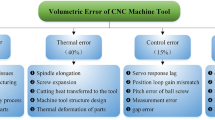Abstract
In this study, to more quantitatively evaluate the structural characteristics of an ultra-precision machine for machining large-surface micro-features, the joint stiffnesses of hydrostatic guideways and bearings were identified based on a virtual prototype and compliances of the ultra-precision machine. The virtual prototype of the ultraprecision machine was constructed to include the joint stiffnesses to be identified, and the joint stiffnesses were identified through an optimization problem in order to minimize the error between the compliances measured from the physical prototype and the compliances predicted from the virtual prototype. In particular, the validity of the identified joint stiffnesses was verified by the fact that the loop stiffnesses of the ultra-precision machine predicted from the virtual prototype and the identified joint stiffnesses coincided well with those measured from the physical prototype.
Similar content being viewed by others
References
Wang, J. H. and Liou, C. M., “Identification of Parameters of Structural Joints by Use of Noise-Contaminated FRFs,” Journal of Sound and Vibration, Vol. 142, No. 2, pp. 261–277, 1990.
Wang, J. H. and Chuang, S. C., “Reducing Errors in the Identification of Structural Joint Parameters Using Error Functions,” Journal of Sound and Vibration, Vol. 273, No. 1–2, pp. 295–316, 2004.
Li, W. L., “A New Method for Structural Model Updating and Joint Stiffness Identification,” Mechanical Systems and Signal Processing, Vol. 16, No 1, pp. 155–167, 2002.
Yang, T., Fan, S. H. and Lin, C. S., “Joint Stiffness Identification Using FRF Measurements,” Journal of Computers & Structures, Vol. 81, No. 28-29, pp. 2549–2556, 2003.
Park, C. H. and Song, C. K., “Ultra Precision Machine Tool for Machining the Large Surface Micro Feature,” Journal of KSPE, Vol. 22, No. 5, pp. 7–15, 2005.
Park, C. H., Song, C. K., Hwang, J. H. and Kim, B. S., “Development of an Ultra Precision Machine Tool for Micromachining on Large Surfaces,” IJPEM, Vol. 10, No. 4, pp. 85–91, 2009.
Kim, S. I. and Cho, J. W, “Structural Characteristic Analysis of a High-Precision Centerless Grinding Machine with a Concrete-Filled Bed,” IJPEM, Vol. 7, No. 4, pp. 34–39, 2006.
Bently, D. E., Goldman, P. and Eldridge, T., “The Depth of Whirl — What the SFCB Can Do for the Stability of Rotation Machinery,” Orbit, Vol. 22, pp. 10–13, 2001.
Press, W. H., Flannery, B. P., Teukolsky, S. A. and Vetterling, W. T., “Numerical Recipes in C: The Art of Scientific Computing,” Cambridge University Press, 1992.
Author information
Authors and Affiliations
Corresponding author
Rights and permissions
About this article
Cite this article
Lee, WJ., Kim, SI. Joint stiffness identification of an ultra-precision machine for machining large-surface micro-features. Int. J. Precis. Eng. Manuf. 10, 115–121 (2009). https://doi.org/10.1007/s12541-009-0102-4
Received:
Accepted:
Published:
Issue Date:
DOI: https://doi.org/10.1007/s12541-009-0102-4




